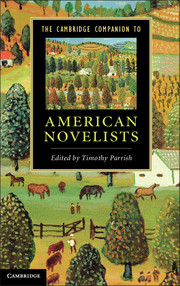Book contents
- Frontmatter
- Contents
- Contributors
- Introduction
- 1 James Fenimore Cooper
- 2 Nathaniel Hawthorne
- 3 Herman Melville
- 4 Harriet Beecher Stowe
- 5 Mark Twain
- 6 Henry James
- 7 Edith Wharton
- 8 Theodore Dreiser
- 9 Willa Cather
- 10 F. Scott Fitzgerald
- 11 Ernest Hemingway
- 12 William Faulkner
- 13 Henry Roth
- 14 Djuna Barnes
- 15 Zora Neale Hurston
- 16 Richard Wright
- 17 Raymond Chandler
- 18 Ralph Ellison
- 19 J. D. Salinger
- 20 Patricia Highsmith
- 21 Vladimir Nabokov
- 22 Jack Kerouac
- 23 Saul Bellow
- 24 Kurt Vonnegut
- 25 John Updike
- 26 Thomas Pynchon
- 27 Toni Morrison
- 28 Philip Roth
- 29 Don DeLillo
- 30 Cormac McCarthy
- Guide to Further Reading
- Index
- References
11 - Ernest Hemingway
Published online by Cambridge University Press: 05 December 2012
- Frontmatter
- Contents
- Contributors
- Introduction
- 1 James Fenimore Cooper
- 2 Nathaniel Hawthorne
- 3 Herman Melville
- 4 Harriet Beecher Stowe
- 5 Mark Twain
- 6 Henry James
- 7 Edith Wharton
- 8 Theodore Dreiser
- 9 Willa Cather
- 10 F. Scott Fitzgerald
- 11 Ernest Hemingway
- 12 William Faulkner
- 13 Henry Roth
- 14 Djuna Barnes
- 15 Zora Neale Hurston
- 16 Richard Wright
- 17 Raymond Chandler
- 18 Ralph Ellison
- 19 J. D. Salinger
- 20 Patricia Highsmith
- 21 Vladimir Nabokov
- 22 Jack Kerouac
- 23 Saul Bellow
- 24 Kurt Vonnegut
- 25 John Updike
- 26 Thomas Pynchon
- 27 Toni Morrison
- 28 Philip Roth
- 29 Don DeLillo
- 30 Cormac McCarthy
- Guide to Further Reading
- Index
- References
Summary
Born in 1899 in Illinois, Ernest Hemingway (1899–1961) came of age during World War I. Rejected by the army because of his defective vision, he volunteered as a Red Cross ambulance driver in Italy and was seriously wounded. He returned home for a brief stay, married and sailed with his wife to France where he settled in Paris and became part of a loose fraternity of American expatriate writers, among them Gertrude Stein, F. Scott Fitzgerald and Ezra Pound, who in various ways influenced his art. As a journalist, he covered the Spanish civil war between the republican government and the fascist Falangists led by Franco. An outdoorsman, he hunted big game in Africa, fished in the waters of Key West and found the spectacle of the matador’s artful encounter with the bull an analogue to his own art. All this activity found its way into his writing as journalist, short story writer, novelist and memoirist. Petrina Crockford vividly sums up the heroic legend that Hemingway fashioned for himself: “He lived a vigorous, adventurous life as brash and uncompromising as that of his greatest characters, inhabiting a male dominated, solitary, and stoic world.” The trouble with the legend, as I hope to show, is that by simplifying his achievement it fails to do it full justice.
Hemingway began his literary career as a short story writer and became one of its greatest masters. No one has better characterized his style than Hemingway himself. “The dignity of the movement of an iceberg is due to one-eighth of its being above water.” His sentences are characteristically crisp, understated (spare in their use of adjectives and adverbs) and resonant, requiring the reader to see and hear what is below the water. The protagonist of his first collection of stories, In Our Time, mostly set in the American Midwest, is the young Nick Adams. “Indian Camp” is exemplary of the iceberg effect. Nick accompanies his father, a doctor, to an Indian camp, where he is to perform without anesthesia a cesarean operation on an Indian squaw. Nick averts his eyes as his father accomplishes the task with admirable skill, but with a less appealing bravado.
- Type
- Chapter
- Information
- The Cambridge Companion to American Novelists , pp. 104 - 113Publisher: Cambridge University PressPrint publication year: 2012

